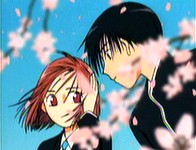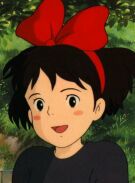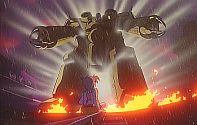
Sora Naegino travels to America to fulfil her dream of joining Kaleido Stage, an incredible circus. Even getting in is hard enough, however, and with opposition from the prima donna of the Stage, Sora's journey to become a Kaleido Star is certainly not going to be plain sailing. In the second season, Kaleido Star: New Wings, Sora faces challenges from an arrogant perfectionist and a new rival eager to take her spot as she discovers what is needed to become a true Kaleido Star.
Kaleido Star adds little new to the shoujo sports cliche established back in Aim for the Ace with its story of one girl's rise to the top, but it is endlessly entertaining thanks to a brilliant cast of characters, a heroine you can really root for and some excellent animation from Gonzo (especially during the various "production numbers" the circus puts on). The New Wings series continues the outstanding animation and vocal talents from the first season, and adds some depth to the plot as Sora faces her own demons as well as the challenges from others eager to take what she wants from the stage.
Licenced by ADV.
[Entry by Andrew Hollingbury and Michael Falkner]

Hitotsubashi Yurie surprises her middle-school friend Mitsue one lunchtime by announcing she has become a god... thus begins a delightfully sweet story of friendship, godhood, aliens, calligraphy, unrequited love, adventure and the climbing of many steep hills. Set in the town of Onomichi on Japan's Inland Sea, this superbly animated series mixes Shinto mythology with schoolwork, magic with lost cats, and makes passing references to other popular anime series like Read or Die.
The entire series runs to 16 episodes on DVD; twelve slightly-edited episodes were shown on TV in Japan. The manga ran in Dengeki Daioh.
Licenced by Geneon, now out-of-print.
[Entry by Robert Sneddon]
TV series, 40+ episodes. Animated by the Sailor Moon anime team, Kamikaze Kaitou Jeanne takes the storyline of Saint Tail and gives it some new twists. Maron is a 16 year old girl with two secrets: an inner loneliness due to her divorced parents' failure to contact her in years; and the fact that she's the reincarnation of Jeanne d'Arc (Joan of Arc). Sadly, Maron's adventures seem to have nothing in common with those of her namesake, except that both are on missions from God. Egged on by the diminutive angel Fin that only she can see or hear, Maron must steal and destroy art treasures that have become possessed by demons. Her missions are hampered by a detective's daughter who is determined to capture Kaitou Jeanne, and by masked rival Sindbad. The bishoujo character styling is very Sailor Moonish, whilst the storyline is Cardcaptor Sakura with added cops'n'robbers. Although the episode plots are feeble and cartoonish, the central character Maron is engaging and just deep enough to make you want to see "just one more" episode.
[Entry by Shez]
See Dagger of Kamui
In a town named 'Paradise' lives Kurusugawa Himeko, a quiet and clumsy girl who lives life at her own pace. A pretty if unremarkable girl, her only specialties are photography and being late.
Himeko quite literally falls into the life of Himemiya Chikane, the 'princess' of the school, and daughter of an influential family. Chikane's popularity is rivaled only by the school's 'prince', Oogami Souma.
Souma is Himeko's childhood friend and every bit Chikane's rival in athletics, popularity, and his attraction to Himeko. Souma's family tends the shrine outside of town.
Upon learning that she shares a birthday with Himeko, Chikane schedules a "private birthday party for just us."
Then things gets weird.
The night before the birthday arrives, and Himeko's musings on the coming party are interrupted by a black moon, and the coming of one of Orochi's heads, who rises from lake as mecha, with the stylings of a Gundam, but a matrial arts move list stolen straight from the Super-Robo genre.
Will it be a happy birthday? Who win Himeko's heart? Will the Orochi bring eternal darkness to the world, or will the sun and moon priestesses seal him away? Stick with Kannazuki no Miko, and find out!
Loosely based on the legend of the Orochi, Kannazuki no Miko is a compelling shoujo yuri unrequited love story with shounen fantasy elements and mecha. Kannaduki no Miko spans 12 episodes. It was licenced in R1 from Geneon Entertainment, and is now out-of-print.
[Entry by Abraham Evangelista]

Yukino Miyazawa is an intelligent and popular student who craves the attention this gives her, and she works hard to keep the impressions she makes in all her classmates' minds. However, on the day of her high school entrance ceremonies, she finds that the position of incoming class representative that she wanted so much has been taken by a boy named Arimi Souichiro. While this enrages her, she eventually finds herself drawn closer to him, and he to her. When their popular masks finally slip in front of each other, they find that they have fallen in love.
This romantic drama was Gainax's first TV series after the legendary Neon Genesis Evangelion, and carries over some of its experimental tendencies, only this time to more comic effect; they carried that over and built on it in future series such as FLCL and Abenobashi Mahou Shoutengai. Based on the popular shoujo manga by Masami Tsuda, and, whilst a quality series, the anime has a frustrating non-ending, since the manga is still running in the monthly LaLa at the time of writing.
Licenced by Right Stuf.
[Entry by David Watson]
See Tsukikage Ran
This entry has been moved to the Anime Hentai Primer
There are aliens living amongst us, and they are plotting the downfall of the Pokopon (or what the Pokoponians call "Earth")! But first, they have to vacuum the living room. Keroro Gunsou is a hilarious anime based on the idea of cute frog-like invaders coming to Earth to conquer us, but instead, through their own ineptness, get in the daily life of a typical Japanese family.
Fuyuki Hinata is a high school student with an obsession for the paranormal, especially UFOs. One morning, he accidentally discovers Sgt. Keroro, the leader of the advanced platoon, hiding behind his wallpaper. Through a series of inept accidents, mostly Keroro's own fault, he accidentally orders the invasion fleet to abort the mission and return to Keron, abandoning him and his team on Earth. His subordinates are Tamama, a sweet natured bi-polar private; Giroro, a no nonsense soldier with a crush on Fuyuki's sister; and Kururu, the tech-wizard and part-time DJ.
Now, Sgt. Keroro and his team are at the mercy of Fuyuki's older sister, Natsume: a fearsome, bossy sister who is the head of the household when their manga-editor mother isn't around (which is most of the time). She puts Keroro to work cleaning the house to pay for his "freeloading" while also trying to foil their plans. So in between making the dinner and dusting the furniture, Keroro, Tamama, Giroro and Kururu, his band of equally quirky frog soldiers, do what they try to do every day: try to take over Pokopon!
Warnings: PG. Fan service (no nudity) Age: 12+
Licenced by ADV, not yet released.
[Entry by Travers Naran]
Tokiko "Key" Mima is a strange, pale, waifish little girl who claims to be an android. Raised by a scientist in a small town, she is forced to strike out on her own when he dies. His dying words to her are a puzzling "In order to make yourself a real girl, you must make 30,000 friends." But things only get stranger from there. Who is the evil Ajo and his henchman "D"? Why are they interested in Key? Is Key really an android? Decent art and animation. Subbed and dubbed. 13 episodes. From Viz.
[Entry by Ben Cantrick]

Kiki, the thirteen-year-old daughter of a witch and a mortal man, strikes out to a new city to live on her own. Despite having no skills other than flying, Kiki manages to hold her own, discovers some secrets to happiness, and falls in love for the first time. A sweet, delightful coming-of-age tale full of Miyazaki's classic storytelling techniques, such as the sweeping visuals of Kiki's aerial scenes and the subtle plays of light and dark as the mood of the film reflects Kiki's blossoming maturity. Like most other Studio Ghibli films, this is just about the most family friendly anime you can get.
Kiki is available in the US from Disney/Buena Vista.
[Entry by Dot Warner]
A tale of a "love triangle", the male protagonist middle school student Kasuga Kyosuke falls in love with Ayakawa Madoka from the moment he meets her but her best friend Hyama Hikaru (2 years younger) falls in love with him when she see what she believes to be an unaided athletic feat. But the Kasuga family hides a secret, that the children Kyosuke & the twins Manami and Kurumi whose mother died have PSI powers. Kyosuke gets into a lot of trouble with Ayakawa mostly using his powers to keep others happy. The action of the series revolves around Kyosuke concealing his love for Ayakawa from not only Hikaru but the classmates, Ayakawa's behavior ("kimagure" means "whimsical") and her old street gang pals, and of course Kyosuke's fantasies. The twins help to stir things up as well, and Kasuga Takashi (the PSI unpowered dad) is a photographer which leads to some very interesting episodes. Studying by the characters helps the story along, as do the grandparents.
This series ran to 48 TV episodes with 8 OVAs and 2 movies, subtitled. The second movie is from the original author of the manga on which the whole series is based, Masumoto Izumi. During the series, reference is made to Ayakawa's musical ability and in the final movie she is a fully developed composer. The music used in the series is somewhat ambigous but suits the amine very well.
Previously licenced from AnimEigo, now out-of-print.
[Entry by bobbie sellers]
Created by Dr. Osamu Tezuka in 1950 as a manga titled Junguru Taitei (Jungle Emperor), this is a story of what it means to be civilized, of love and loss, and of the need for greater understanding between all creatures, especially between humans and animals. Along the way you get spiritualism, greed, treachery, love, insanity, and sacrifice. In 1965, the first portion of the manga was adapted into the first color anime series, which kept the manga's title in Japan but became known as Kimba the White Lion in the rest of the world. This was a co-production between Tezuka's Mushi Productions and NBC Enterprises; as a result of the Americans' input, the story was changed considerably, but these changes served to highlight the aspect of the interaction between humans and animals. The American verison was expertly dubbed into English by ex-radio actors; unfortunately, they were ordered to lighten the tone of the stories considerably. A vital part of the success of the show was the musical score, written for full symphony orchestra by Isao Tomita. The show was shown in the US only betwen 1966 and 1978, but retains a huge fan base today. Since then, a new English dub (with new music) was produced in 1993, which is currently in syndication. A sequel series was produced in Japan in 1966, which made it to the US in 1984 under the title Leo the Lion. Tezuka Productions made a revised series in 1989; in edited form this is partially available English-dubbed on home video as The New Adventures of Kimba. The latter portion of the original manga story was made into a feature film in 1997, available in English as Jungle Emperor Leo.
Licenced in North America by Right Stuf.
[Entry by C Andersen]
Perhaps best described as a mixture of Lupin III and early Dragonball; this shows the adventures of a teenaged master thief named Jing and his love-hungry talking albatross sidekick, Kir. Jing and Kir go after great riches in a world full of bizarre characters, cities and kingdoms, often accompanied and advised by the mysterious Postino. If you like the more offbeat styles of anime, this is for you.
Licenced by ADV in North America and the UK, and by Madman in Australia.
[Entry by Andrew Kieswetter]
A quietly nihilistic series that makes for a nice contrast with the large number of colourful and perky series out there, Kino's Journey tells the story of a young wanderer and a robotic motorcycle who journey through various countries, staying no more than three days at a time. Many of the countries and individuals encountered either engage in self-destructive behaviour or have ugly aspirations. Kino, while largely a moral agent, at times skirts the line of amorality in just drifting through these situations.
This is a fascinating series with solid storytelling that's chock full of black humour, irony, surrealism and cynicism. Despite the general downbeat nature of this series, there's a undercurrent of happiness to it (not a little of which is embodied in the very laid-back Kino).
Available in North America from ADV Films.
[Entry by Michael Lo]

Seven OAV Episodes of Mecha Action Against Aliens during the 1940's!
Japanese mecha fight against exploding alien blobs in vaguely humanoid form that drop from the skies wielding machine guns during World War Two. (The command modules that control the mecha embody the alien technology.)
Car chases, Railroad battles, Submarines; war orphans pulling together to help the good guys: the Kishin Corps.
Our young hero Taishi grows up over several years as the scene (and the freight train) moves from Manchuria to Tunisia to Switzerland to the alien base in Germany. Nice scenery, including that Swiss lake. Several changes of allegiance, with the Corps on the side of the British and Americans. (Can you imagine Albert Einstein and Eva Braun on the same side?)
The British Union Jack is displayed more prominently than the Japanese Hinomaru - but then, so is the Nazi Swastika.
Released in North America by Pioneer/Geneon, now out-of-print.
[Entry by Austin Watkins]
Sana Kurata is a child actress renowned for her hyperactivity and her role on the TV show of the title (yes, a show within a show; cute, innit?), and is the adopted daughter of the eccentric author Mariko Kurata. Despite her stardom, she still goes to a non-exclusive school, in which her class is terrorized by a bully named Akito Hayama, a cold and quiet boy who manages to rally the other boys around him and make the class hell for the teacher. When Sana decides enough is enough and stands up to him to try to get him to stop, she discovers just how troubled he and his life actually are, and eventually goes from enemy to friend ... or is it even more?
Zany comedy and very touching drama exist side by side in Kodocha's shoujo frame, and it still manages to work very well. The anime is licenced by FUNimation in North America, and by MVM in the UK. TOKYOPOP is releasing Miho Obana's manga under the name Kodocha.
[Entry by David Watson]
Koi Kaze deals with sibling love. It is also a warning against divorce and sibling separation. In this case the father is responsible for the divorce which separated the older brother, Saeki Koshiro, from his 12-years-younger sister, Kohinata Nanoka. The two meet without knowing who they really are, and a love begins.
Nanoka has an easier time accepting her feelings than Koshiro, who goes through considerable emotional torment a severe emotional involvement. This contains lots of poignancy as the relationship will fall outside acceptable social limits and expose them to persecution, if not prosecution. Nanoka does have problems with love sickness noted by her high school friend, and then with the abandonment of the friend to be with Koshiro.
A co-worker of Koshiro's, Chidori Kanane learns of the situation and externalises all the negativity he has been feeling. Nanoka drives her off as she attempts to come between the inappropriate couple. She also works the previews as a dominatrix.
The most physical affection we see between Koshiro and Nanoka is hugging.
If the creators had wanted a real polemic against incest, they might have continued down the path a few years after Nanoka has completed school and they live together under social pressure and in obscurity, but instead they concentrate on the initial encounters and the realisation of the problem. It ends hopefully with Koshiro's acceptance of his love for Nanoka.
13 episodes, fully acceptable English voice actors and good subtitles, standard extras plus a little bear playlet in the last volume.
Three DVD volumes from Geneon, now out-of-print.
[Entry by bobbie sellers]
see Porco Rosso